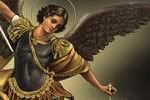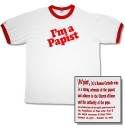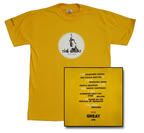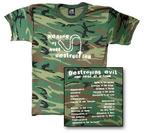Holy Thursday...
...a little late I admit, but still worthwhile. I often read and reflect over the words of a priest affectionately called "Cappie". I discovered him at phatmass.com and have on numerous occasions been made more aware and thusly more moved by the readings at Mass. The readings are posted and he replies generally with a synopsis, what we should look for in them, and then his own personal homily. I thought it would be nice to share his recap for Holy Thursday before jumping into my experiences at Mass.
Introduction: On Holy Thursday we remember with gratitude the Pascal mystery of the suffering, death and resurrection of Jesus, and the transformation of the Jewish Passover into the New Testament Passover. The Jewish Passover was, in fact, a joint celebration of two ancient thanksgiving celebrations. The descendants of Abel, who were Shepherds, used to lead their sheep from the winter pastures to the summer pastures after the sacrificial offering to God of a lamb. They called this celebration the “Passover." On the other hand, the descendants of Cain, who were farmers, held a harvest festival called the "Massoth" in which they offered unleavened bread to God as an act of thanksgiving. The Passover feast of the Israelites (Exodus 12:26-37) was a harmonious combination of these two ancient feasts of thanksgiving, celebrated to thank God for the miraculous liberation of their ancestors from Egypt and their exodus to the Promised Land.
The Jewish Passover was a seven-day celebration, during which unleavened bread was eaten. The Passover meal began with the singing of the first part of the “Hallel” psalms,” 113 &114, followed by the first cup of wine. Then they ate bitter herbs, sang the second part of the “Hallel” psalms, drank the second cup of wine and the oldest man in the family explained the significance of the event, in answer to the question asked by a child. This was followed by the eating of the flesh of a lamb roasted in fire whose blood was offered to God as an act of thanksgiving. The participants divided and ate the roasted lamb and unleavened “Massoth” bread, drank the third cup of wine and sang the major “Hallel" psalms, 113-118. In later years, the Jews celebrated a mini-form of the Passover every Sabbath day and called it the “Love Feast.”
In the first reading from the book of Exodus, God gives the Hebrews two instructions: ‘prepare for the moment of liberation by an annual ritual meal and make a symbolic mark on your homes to exempt yourselves from the coming slaughter.’ In the second reading, Paul quotes another source for this tradition that was handed to him upon his conversion. He says he received this "from the Lord,” suggesting that the celebration of the Lord's Supper was an unbroken tradition from the very beginning of the church. Paul implies that the purpose of this celebration was to proclaim the death of the Lord until he comes again. He may mean simply that Christians, by this ritual act, remind themselves of the death and resurrection of Jesus, and he may also mean that Christians prepare themselves for the proclamation of Christ to the world at large. In harmony with these readings, today’s gospel describes how Jesus transformed the Jewish Passover into the Eucharistic celebration. First, he washed their feet - a tender reminder of his undying affection and a quiet plea for them to do the same for each other and reminding us that our vocation is to take care of one another as he always takes care of us. Then he gave them his own body and blood as food, so that as long as they lived, they'd never be without the comfort and strength of his presence. Thus he washed their feet, fed them, and then went out to die.
Exegesis: Jesus began his Passover celebration by washing the feet of his disciples as a lesson in humble service because it was the duty of slaves. He followed the Jewish ritual only up to the second cup of wine. Then instead of serving the roasted lamb, Jesus offered himself to them as the true Pascal Lamb by instituting the Holy Eucharist as a sign of God’s perpetual presence with His people and their heavenly food. This was followed by the institution of the priesthood with the command, “Do this in memory of me." Jesus concluded the ceremony by a long speech incorporating his command of love: “love one another as I have loved you.” There are several natural connections between the Jewish Passover celebration and the Christian sacrament of the Holy Eucharist. Jesus instituted the sacrament of the Eucharist at a private Passover observance with his disciples (Matthew 26:17-30; Luke 21:7-23). He served as both the Host and the Victim of sacrifice. As He presided over the meal, he infused the familiar Passover elements with new meaning. He was the Lamb of God, as John the Baptist had previously predicted (John 1:29, 36), who would take away the sins of the world.
The early Jewish Christians converted the Jewish “Sabbath Love Feast” into the “Memorial Last Supper Meal” of Jesus. It probably consisted of praising and worshipping God by singing psalms, reading the Old Testament Messianic prophecies and listening to the memoirs of the apostles. This was followed by a procession, the recital of the “institution narrative” and the partaking of the bread and wine as the "body and blood of Jesus.” This finally evolved through the centuries into the present day Holy Mass.
Messages: 1) A message of humble and selfless service. Our celebration of the Eucharist requires that we wash one another’s feet, i.e., serve one another, and revere Christ's presence in other persons. It means that we become great only by serving others.
2) A message of sacrificial and self-giving love. Let us imitate the self-giving model of Jesus who shares with us his own body and blood and who enriches us with his Real Presence in the Holy Eucharist. Even when he was about to die, he showed compassion and love to those who loved him. How many times does it happen that when we suffer we inflict our sufferings upon others as we feel sorry for ourselves or anger at others?
3) A message of unity and suffering. The bread we partake of is produced by the pounding of many grains of wheat, and the wine is the result of the crushing of many grapes. Both are thus symbols of unity and suffering. They invite us to share our lives and its blessings with others, and to support them in their pain by sacrificial sharing.
4) Make the Holy Communion an occasion of divine grace and blessing by its worthy reception, and not an occasion of desecration. That is why the priest prays just before he receives Holy Communion in the ancient Syro-Malabar oriental liturgy in Aramaic the language spoke: “Lord Jesus Christ, with faith in your love and mercy I eat your body and drink your blood. Let it not bring me condemnation, but health in mind and body.” Let us receive Communion as a sacrament, an outward and visible sign of an inward and spiritual grace. Grace is God's favor towards us, by which God forgives sins, enlightens minds, stirs hearts, and strengthens wills. Let the grace of this Holy Communion make us one body, one spirit in Christ, that we may worthily serve the world and one another in his name.













0 Comments:
Post a Comment
<< Home